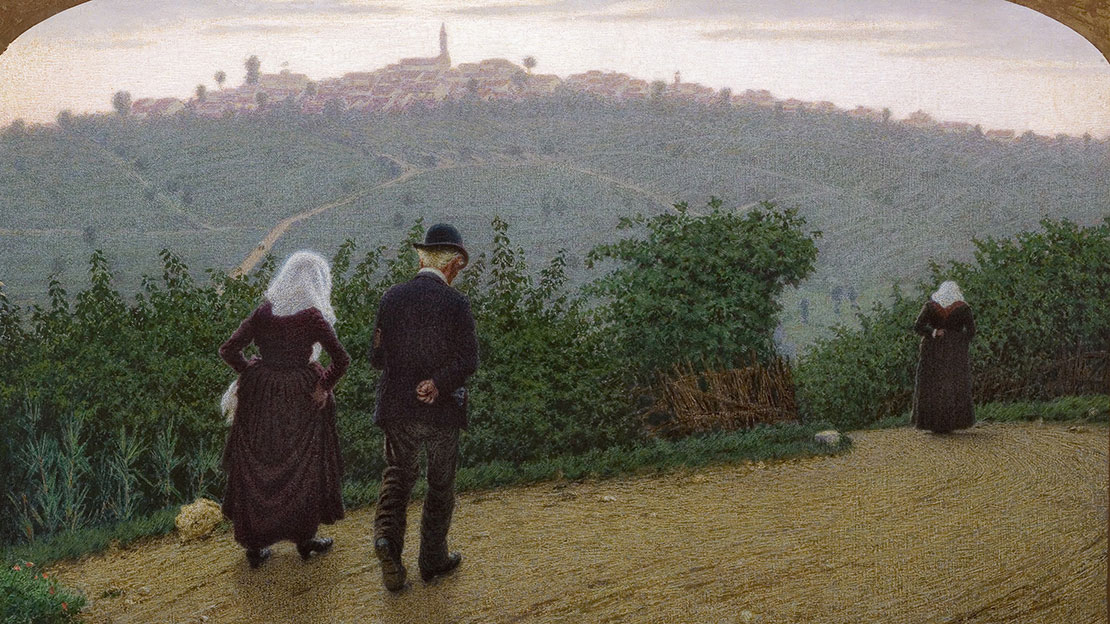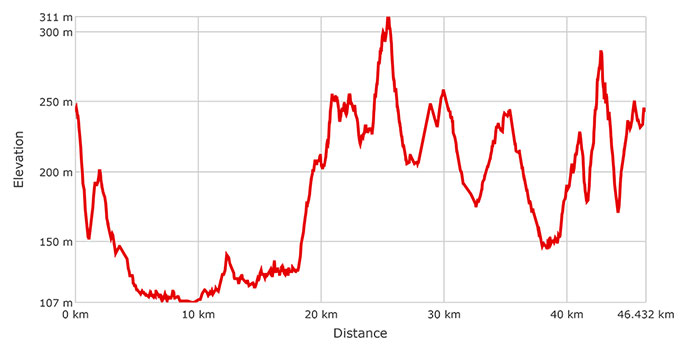
- Bike: trekking
- Difficulty: **
- Distance: 47 km
- Altitude difference: 204 m
- Total ascent: 810 m
- Total descent: 811 m

The painter Angelo Morbelli was born in Alessandria on 18 July 1853. His father Giovanni was a wealthy owner of vineyards in Colma, near Rosignano Monferrato, where you can still see the Morbelli family's country house. The non-profit association Amis d’la Curma ('friends of Colma' in the local dialect), together with the painter's descendants, promotes the work of this Divisionist master. Among their most important projects is the 'Angelo Morbelli' painting contest, held every year in July.
Our itinerary introduces you to the artist's work through reproductions placed at various points on the route. Start in Colma and head off in the direction of Terruggia. The first painting you see is Angolo di Giardino ('Garden corner', 1919). On your right, a few metres on, after the headquarters of Amis d’la Curma, you see Riposo alla Colma ('Rest at Colma' 1894-1898). Start going downhill and after 200 m, on your right, you see Villa Maria, named in honour of Angelo's beloved wife and muse. Here you can visit the painter's studio. Outside the villa are Distendendo panni al sole ('Hanging laundry in the sun', 1916) and Lezione all’Aperto ('Outdoor lesson', 1890), while in the courtyard you find Il Telegramma ('The telegram', 1915). Go down another 200 m and on your right you find the painting Visita alla Stalla ('Visit to the stable', 1886) and further on, Alba Domenicale ('Sunday dawn', 1915). When you're almost out of the village, you see Ritorno alla stalla ('Return to the stable', 1889). At the crossroads, go down on your left then up again to Terruggia. In the middle of the village you see a painting that mirrors the landscape behind it: another copy of Alba Domenicale (1915). Leave the village by descending to Via Cacciolo and go left at the fork for Strada Rotte S. Quilico. Cross the SP 50 at the junction, taking great care, and get onto the small road in front of you leading to the farm business Agricola San Lorenzo. When you spot a track on your left, take it and then go right onto the SP 31. Turn right here, again paying attention to traffic, and take the bridge on your left soon after. Get onto a grassy track that will take you along Canale Lanza to Occimiano's residential area. Here, between the irrigation canal and the rice fields, you can't miss Per ottanta centesimi ('For eighty cents', 1895), a work dedicated to female rice workers. The route carries on through Camagna Monferrato, first going along the road to San Maurizio di Conzano and then some tracks along the bottom of the Rotaldo valley. The village of Camagna hosts S’avanza ('It's coming', 1894) for this project. It was painted at Villa Maria and on the background is the Monferrato landscape, with the graceful dome of the church of Sant'Eusebio in Camagna Monferrato. Carry on to Vignale Monferrato, where you find another copy of Riposo alla Colma (about 1894/1898), showing the town in the distance and the bell tower of the parish church of San Bartolomeo. The route goes on in the direction of Casorzo, then Ottiglio, Olivola and Frassinello Monferrato. Continue along the Ghenza valley to Rosignano Monferrato, where you can see the painting Bocche di Leone ('Snapdragons', 1914). Go down and then up to Castello d’Uviglie, where you find Strada del Monferrato ('Monferrato road', 1873). Pedal on a bit further to Colline nel Monferrato ('Hills of Monferrato', 1915-1916) and Colline a Rosignano ('Hills at Rosignano', 1916). Turn off towards the hamlet of Roveto, where La partita a bocce ('The bowls match', 1885) stands in a pretty garden. Meander back to Colma, stopping by the small church of San Bartolomeo, where you find the last painting on the route, Il Viatico ('Viaticum', 1884).
